
The Triumph Spitfire is a British front-engined, rear-wheel drive, two-passenger convertible sports car introduced at the London Motor Show in 1962 and manufactured between 1962-1980. Styled for Standard-Triumph in 1957 by Italian designer Giovanni Michelotti, the Spitfire was manufactured for the duration of its production at the Standard-Triumph Canley works — and evolved over a series of five production iterations, with approximately 315,000 manufactured over 18 years.

The Triumph Bonneville is a standard motorcycle featuring a parallel-twin four-stroke engine and manufactured in three generations over three separate production runs.

AMAL was a British engineering company servicing the motorcycle and other light-engineering motor industries between 1927 and 1993 based in Birmingham, England.
Norton-Villiers was a British motorcycle manufacturer formed in the 1960s following the collapse of AMC. With the general decline of the British motorcycle industry, under a British Government initiative it was later combined with the remnants of BSA Triumph to form Norton-Villiers-Triumph.

Douglas Lionel Hele was a pioneering British motorcycle engineer with Triumph and other firms: BSA, Douglas and Norton. He was born in Birmingham in 1919 and died in Hagley, Worcestershire on 2 November 2001.

The BSA Super Rocket was a 646 cc (39.4 cu in) air-cooled parallel twin motorcycle produced by Birmingham Small Arms Company (BSA) at Small Heath, Birmingham introduced in 1957. It was an improved sports bike member of the BSA A10 series of motorcycles which was developed from the BSA Road Rocket. The A10 had a reputation for reliability but was struggling to compete against the Triumph engines and the Norton Featherbed frames. The model was discontinued in 1963 when the unit-construction A65 was introduced.
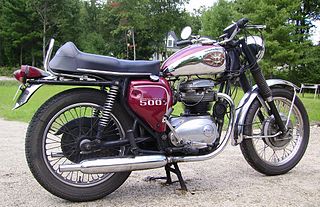
The BSA Royal Star was a Birmingham Small Arms Company (BSA) motorcycle whose new engine design paved the way for a range of successful unit construction twins. As well as giving a clean look to the engine, with the pushrod passages part of the cylinder block casting, unit construction reduced the number of places oil could leak from.

The T140W TSS was the last motorcycle model made by Triumph Engineering at their Meriden factory.

The Velocette Thruxton was a sporting motorcycle produced by Velocette between 1965 and 1971. Revealed at the 1964 Earls Court Show, it was the final development of Velocette's antiquated pushrod single, the Venom.

The Velocette Venom was a 499 cc single-cylinder four-stroke British motorcycle made by Velocette at Hall Green in Birmingham. A total of 5,721 machines were produced between 1955 and 1970.
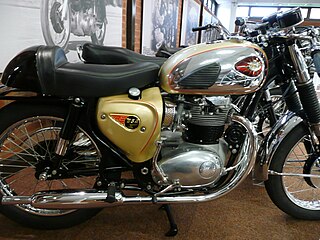
The BSA Lightning Clubman was a 650cc British motorcycle made by BSA at their factory in Birmingham between 1964 and 1965. Finished in gold and black the Lightning Clubman is now a highly sought after classic motorcycle. Due to the very limited production numbers replicas are created by enthusiasts from the BSA Lightning.
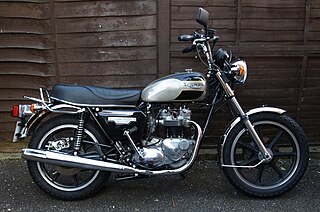
The Triumph Bonneville T140 is a standard motorcycle with a 750 cc (46 cu in) capacity engine that was designed and built by Triumph Engineering at Meriden near Coventry.

The Norton P11 was a 745 cc (45.5 cu in) air-cooled OHV parallel twin motorcycle made by Norton-Villiers from 1967 to 1969. Designed as an extremely light high power-to-weight ratio desert racer, P11 was revised in 1968 to the P11A and marketed as the Norton Ranger, a road legal version of the P11 with a more comfortable seat to make it suitable for normal road use. The Norton P11 gained a reputation as a 'desert racer' in the late 1960s but by 1969 lighter two stroke desert racers began to dominate the sport and the Norton had begun Commando production and it was selling well. Norton ended production of the P11 series to concentrate on the Commando, which used a number of ideas developed on the P11 series.

The BSA Thunderbolt was a British motorcycle made by BSA at their factory in Armoury Road in Small Heath, Birmingham between 1962 and 1972. Fitted with a single carburettor it was capable of over 100 mph (160 km/h).
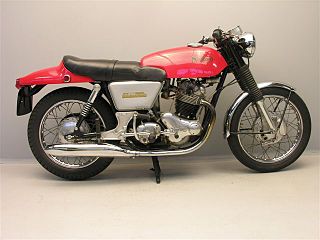
The isolastic frame, designated by Norton as GlideRide, used a system of engine-to-frame mountings incorporating rubber bushes to isolate the vibration of the vertical twin engine from the frame and rider. The isolastic frame was developed for use with the Commando inclined engine, whilst the Featherbed frame continued in production for the Mercury with a softer-specification 650 cc vertical-engine until 1970.
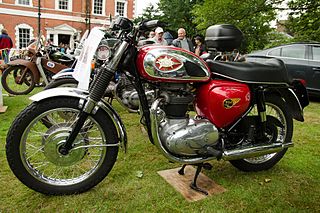
The BSA unit twins were a range of unit construction twin-cylinder motorcycles made by the Birmingham Small Arms Company (BSA) and aimed at the US market. A range of 500 cc (31 cu in), 650 cc (40 cu in) and 750 cc (46 cu in) twins were produced between 1962 and 1972, but they were really developments of the older pre-unit A7/A10 model range with less weight. The engines had a reputation for vibration, but acceleration was good for the time, to a top speed of 100 miles per hour (160 km/h).
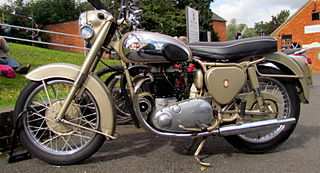
The BSA A10 series was a range of 646 cc (39.4 cu in) air-cooled parallel twin motorcycles designed by Bert Hopwood and produced by Birmingham Small Arms Company at Small Heath, Birmingham from 1950 to 1963. The series was succeeded by the A65 unit construction models.

The BSA B25 was a series of 250 cc (15 cu in) unit construction single-cylinder OHV four-stroke motorcycles made by the Birmingham Small Arms Company. Developed from the BSA C15, the machines were produced between 1967 and 1971. The B25 was the fastest British production 250.
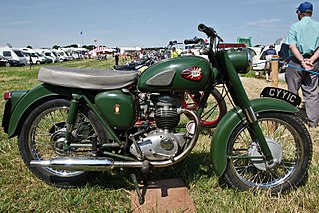
The BSA B40 was a series of 350 cc (21 cu in) unit construction single-cylinder OHV four-stroke motorcycles made by the Birmingham Small Arms Company. Developed from the BSA C15, the machines were produced between 1961 and 1967 for civilian use. Military versions were manufactured from 1967 to 1970. Around 14,000 machines were built in total.
The Ducati 450 Mark 3 is a 436 cc (26.6 cu in) single cylinder bevel drive SOHC motorcycle produced by the Italian manufacturer Ducati from 1969 to 1974. The 450 was largest displacement version of the OHC single series produced by Ducati and used the 'wide case' engine. A higher performance version, the Ducati 450 Mark 3D, which used desmodromic valves was also available. The 450 was criticised for vibration and lack of performance compared to other models such as the Mach 1.





















